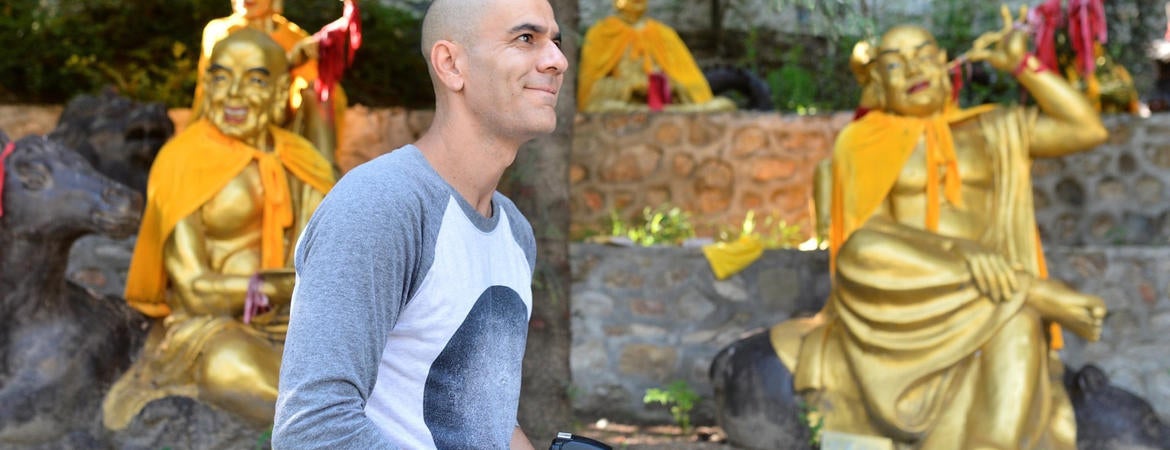College of Humanities, Arts, and Social Sciences

You may have already seen Professor Amir Zaki on campus. On Tuesdays, you can find Zaki teaching his weekly free tai chi class to UCR students, faculty and staff, beneath the shaded trees between Hinderaker and INTS buildings. On Thursdays, he also teaches a free yoga class in the INTS round room.
From yoga and tai chi, to teaching and studying art, to starting his own business, Zaki has left a creative mark wherever he goes. A photographer, Zaki has been teaching art at UCR since 2000. Zaki graduated with a B.A. in art from UCR in 1992, and obtained an MFA from UCLA in 1999, specializing in photography.
This summer, Zaki was invited to host an art exhibition in China and spoke to us about his travels, his business venture, and passion for tai chi and yoga.
Please tell us about your exhibition in China.
I was invited as one of 10 international photographers to photograph in Dalian, China, in August. In September, I went back to the exhibition openings at the Dalian Modern Museum. In this museum, I had two shows. One of the photographs I made in August in Dalian and another ‘survey’ show of highlights from work I've made over the last two decades.

Any interesting experiences or stories during your trip to China?
Many. I visited Beijing as well as Dalian. I wouldn’t know where to start because I did and saw so much in a short period of time. I visited the Great Wall, ate jellyfish soup, had incredible conversations with locals, genuinely connected with people without sharing a common language (including a seven-year-old girl who was my favorite), went to parks that had literally hundreds and thousands of senior citizens exercising, etc.
Who are your artistic influences and what area of photography do you focus on?
Historically speaking, I love photographers like Edward Weston, Minor White, Roy de Carava, Diane Arbus, Ralph Eugene Meatyard. Contemporary artists I like a lot are Hiroshi Sugimoto, Rodney Graham, and Sharon Lockhart.
My own work has focused mainly on both the built and natural landscape of California. I am among a generation of photographers who truly embraced digital technology as a way to make photographs that could not be made using only traditional means.
You offer tai chi and yoga classes on campus. How long have you been practicing and what drew you to practice both?
I have been practicing yoga for 16 years and Yang style Taijiquan (taichichuan) for six years. I received my certificate to teach yoga in 2015 with no intention to teach. However, I went through some difficult life experiences and considered that I had something to offer and share, a relatively deep understanding of these mind/body practices that could very likely benefit others.
What inspired you to host the classes here at UCR?
I really believe that the culture would be healthier both physically and mentally (no real difference) if they embraced and understood and practiced these types of moving meditation. From the feedback I get, I think that the fact that I offer these classes for free and the quality is good, that I am appreciated. That’s good enough for me. I get a great deal of gratification out of sharing my experience with others.
You are the founder of the Infinity Strap. What inspired you to create it and can you give us some background on what the product is?
Yes, in 2011, after rigging up a prototype with duct tape, an idea spontaneously appeared in my mind as I was doing yoga. That idea was to design a strap with two loops, in a figure eight or infinity shape. This would basically replace or offer an alternative to the traditional yoga strap which is long (usually much too long), cumbersome and has a bucket that is both hard on the skin and constantly needs readjustment. The Infinity Strap instead is sewn in the middle creating two stable loops that can wrap easily around your wrists, feet, across elbows or a combination of these areas to help the practitioner get extra length in their body and practice safely. I have a US utility patent for the Infinity Strap and another US design patent for a specially shaped yoga block called BRIK. It’s a perk that I can offer my students at UCR all these props to use for free during our classes if they need. (Learn more about the Infinity Strap and Zaki’s other ventures at www.infinitystrap.com)
What are some new projects you are currently working on?
I’m focusing all my energy on photography at the moment. No products. However, I did collaborate with my colleague and good friend in our Art Department, Jim Isermann. He designed a sort of infinity sign design that is printed on our brand yoga mats.
What is the best thing about working in CHASS?
I have a great job, really. I’m a professor at a research institution that I believe in. It’s like winning the lottery. The best thing about my job is that I get to reinvent my classes anytime I think it’s appropriate. I get to incorporate my research interests into teaching. I get to talk about eastern and western philosophical ideas with my classes, and my colleagues are amazing in the art department. We have an incredibly close-knit and small group of full-time faculty, and we all communicate openly with one another, share ideas, argue, and respect one another deeply. The whole faculty is made of practicing artists who have a great diversity of life experiences, sensibilities, agendas, and interests.
During fall quarter, Zaki will focus on photography while teaching Intermediate Analog Photography.
Learn more about Zaki’s free tai chi classand yoga class.Both classes are open to all UCR students, faculty and staff.
Follow Zaki on Instagram at @amir_zaki_